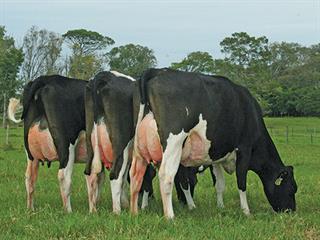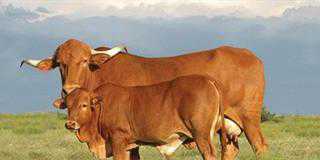
Ruminants need trace elements, including zinc, manganese, copper, selenium, iodine and cobalt, in very small amounts. Trace elements are essential to many biological processes in the animal, including growth, reproduction and a functional immune system. Early studies showed a need for trace elements in successful cattle farming and in optimum wool, meat and milk production from ruminants. If imbalances or deficiencies are marginal, grazing animals may not show clinical signs of abnormal metabolic functions.
But the long-term impact on growth, reproduction, health and profit can be substantial. Unfortunately, in formulating supplements for grazing animals, the importance of macro-minerals and trace elements is often overlooked. Minerals generally have less impact than protein and energy on overall performance and economic efficiency, but they are as necessary in a balanced diet. Without nutritional balance, animals cannot reach their genetic potential.
Growth and production
Ruminants need trace elements in varying amounts according to the species, the production stage, the concentration of trace elements in the grazing and their bio-availability, stresses or disease challenges and the presence of antagonists.
There is more and more evidence that higher levels of trace elements should be fed than those currently scheduled. This is especially true for highly productive animals, those with a high reproductive rate, and in cases where there are imbalances or induced trace element deficiency due to the presence of antagonists.
Rumen micro-organisms also make use of trace elements for effective digestion of grazing or feed. Current feeding recommendations for many elements are based on research that was done decades ago and may not suit today’s production and stress situations. The immune system may have a higher requirement than that indicated by those traits normally measured when determining minimum animal requirements.
The use of more sophisticated genetic selection procedures (BLUP) in the last 15 to 20 years has increased livestock productivity. Improved growth and reproduction potential alters ruminant nutritional requirements, but trace element inputs have not been accordingly tweaked. Published trace element recommendation tables for ruminants are primarily based on body weight and the prevention of clinical signs of deficiency under normal conditions.
They do not take increased growth, reproduction and the introduction of stress into account. Contemporary livestock systems aim to supplement beyond correcting for deficiencies, and focus on minimising stress and optimising production efficiency. Nutrition consultants now routinely recommend trace element inclusion at higher rates than those in published guidelines.
Diet, deficiencies and digestibility
Trace mineral deficiencies are more likely to occur in grazing ruminants and those fed locally grown feed. Grazing ruminants depend on intake of trace elements to supply their dietary requirements. Grass will rarely contain more than one-third of the desired element intake and forages vary widely in element content, as a consequence of species, stage of maturity, soil type, seasonal and temporal climatic factors, and soil fertility or fertiliser applications.
Changes in pasture quality (energy and protein digestibility) pasture contamination, and faecal and soil ingestion complicate the estimation of absorption and digestibility of trace elements by grazing ruminants. This makes it difficult to calculate ruminant needs.
Trace element deficiency is often caused by interactions between the minerals and with other dietary components. These interactions can make the trace mineral biologically unavailable. As deficiencies may not be physically detectable or may manifest gradually over a period of time, they can easily go unrecognised. Marginal deficiencies, under low levels of production become more severe, and previously unsuspected nutritional deficiency signs usually occur when production increases.
Response to treatment (trace element dose-response trials) remains the most effective test for deficiencies. It is also the most effective method for determining the presence of a marginal deficiency and whether depleted reserves of a trace element are associated with impaired productivity. If it is not possible to do a dose-response trial, we rely on liver and blood analyses to determine deficiencies.
Supplementation
Various methods (free-choice lick, drenches, etc.) are available for supplying trace elements to the grazing animal.
Supplementation via free-choice licks is one of the cheapest options. The disadvantage is that intakes are not regulated. Intake variability, inadequate intake and the presence of antagonists, which make some trace elements biologically unavailable are problematic in this form of supplementation.
The most common antagonists are calcium, iron, sulphur and molybdenum, often over-supplied through licks, rations, drinking water and grazing. Therefore, in most grazing situations, trace mineral-containing licks cannot provide sufficient trace element intake to meet nutritional needs.
Chelation, the process of bonding trace elements to organic compounds, is one method of overcoming antagonism so that elements are more bio-available to the animal. Partly (20% to 30%) replacing the inorganic trace elements in licks with organic (chelated) trace elements is practised by leading feed companies. Unfortunately it does not solve the problem of variation in lick intake.
Up to 18% of animals in a flock or herd do not take any lick while up to 30% do not ingest adequate lick. However, an important aspect still remains the continuous monitoring of lick intake to ensure optimum intake. Because of the problems encountered in trace element supplementation via free-choice licks, oral or injectable supplementation of chelated elements is becoming a favoured method to guarantee trace element status of grazing ruminants in conjunction with licks.
Dosing or injection of chelated trace elements is specifically targeted during periods of stress and high demand (i.e. four weeks pre-mating, four weeks pre-lambing or pre-calving, at weaning, at introduction to grass- or feedlotting) when there is a high probability that an economic response will be obtained. According to research, additional inputs in terms of trace elements are required to support pregnancy and lactation over and above requirements for maintenance and growth.
Energy, protein and/ or bypass protein are the primary limiting nutrients in the grazing animal’s diet. When the environment or the management regime limits one or more of these primary nutrients, trace element supplementation will not elicit a response. Excellent results have been obtained with a three-phase lick programme (phosphate, protein and production lick) supplying the necessary nutrients such as protein, bypass protein, energy, macro minerals and trace elements of which more than 20% are in an organic format.
This is then boosted by dosing or injecting chelated trace elements four weeks before mating and four weeks before lambing or calving. Dosing or injecting vitamins A and E may also be done at each occasion. Lambs and calves receive oral or injectable supplementation of chelated elements and vitamins at weaning since it plays a pivotal role in supporting their immune system and growth. Breeding rams and bulls receive three doses or injections of chelated elements and vitamins annually, of which one is two months before the breeding season.
Supplement to suit your area
Researchers worldwide say producers should have a solid traditional trace element supplementation programme in place. Licks or rations, in which two-thirds of the trace elements are in an inorganic and one-third in an organic format can be used in combination with dosing or injecting chelated trace elements.
Oral or injectable supplementation of chelated trace elements should be considered as a top-up to a lick programme, thus a complementary route for critical trace element demands to improve reproduction, production and immune function. There is now enough scientific evidence that these chelated elements should be supplemented during stressful conditions or when high performance is required to increase the profitability of the enterprises. Trace element supplementation should be done in conjunction with an effective animal health management programme to obtain the best response.
Parasite infestations, endemic to all pasture systems grazed by ruminants, will increase the dietary requirement
for elements. Animals with a sub-optimal trace element status will not immunise properly when vaccinated. If your animals are trace mineral-deficient, you are just throwing vaccines and antibiotics away. A correctly maintained trace element balance and status will help animals achieve optimum production levels.
Trace mineral supplementation should be based on expert advice specific to an area, not on recommendations in published tables, which are at most, guidelines for normal conditions.
For more information phone Dr Jasper Coetzee, sheep nutritionist and management specialist consultant, on 076 846 8800 or email [email protected].












